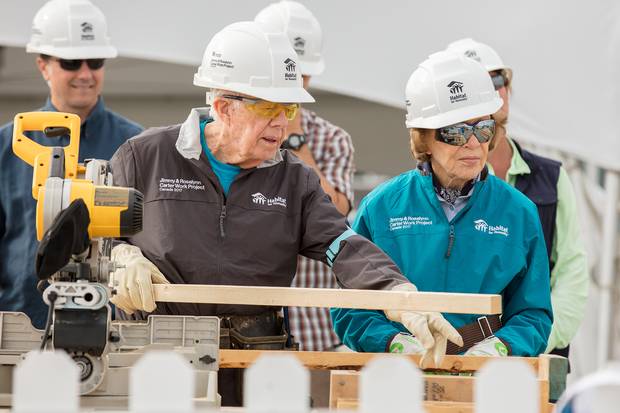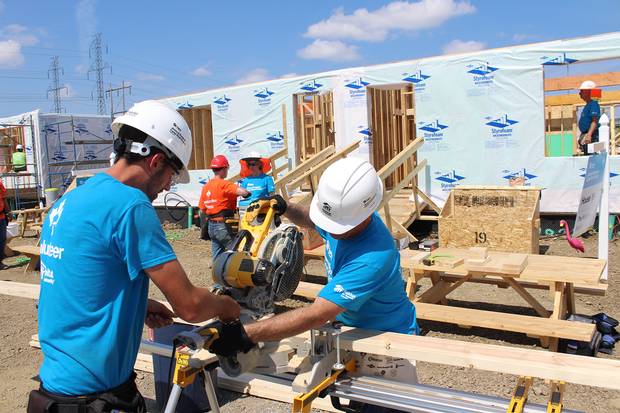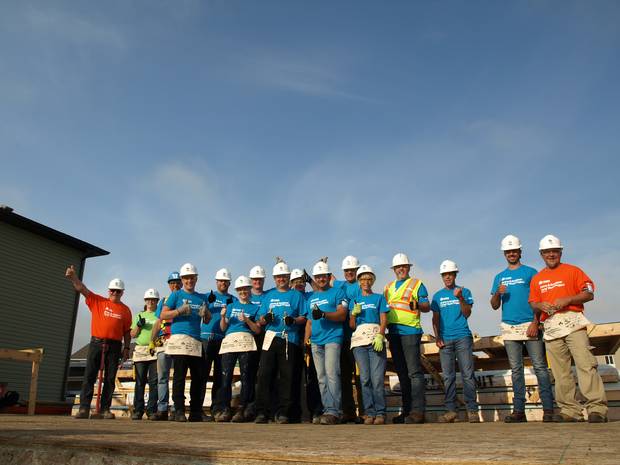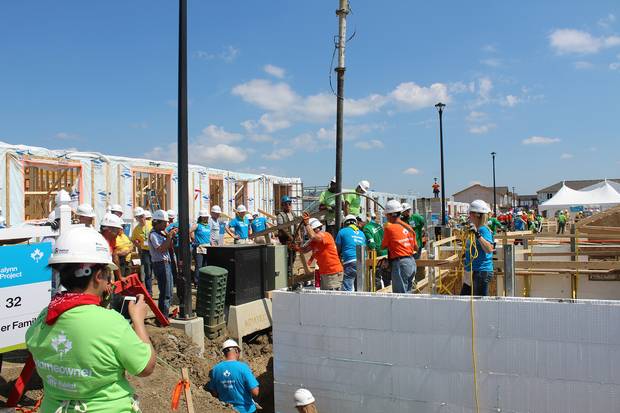Many hands made light work last month as Habitat for Humanity Edmonton enlisted the labour of more than 1,000 volunteers to build 75 homes for low-income families in northern Alberta – alongside former U.S. president Jimmy Carter and former first lady Rosalynn Carter.
The build was part of this year's Carter Work Project, which has taken place annually since 1984 and involves a week-long effort to build and raise the profile of affordable housing in a location around the world.
In total, 150 homes will be built across Canada to commemorate the country's 150th anniversary. Northern Alberta accepted the challenge to build the lion's share with a 58-unit townhouse project, called Carter Place, in southeast Edmonton, and a 17-unit townhouse project in Fort Saskatchewan.

Former U.S. president Jimmy Carter and his wife Rosalynn.
Habitat for Humanity
A further 25 homes will be built in Winnipeg and other Manitoba locales and the remaining 50 are planned for other territories and provinces across Canada.
"Edmonton is the biggest Habitat for Humanity affiliate in Canada, we build more housing for low-income families than any other city, so it made sense that we would build the majority for the Carter Work Project," says Alfred Nikolai, president and CEO of Habitat for Humanity Edmonton. "Though at the time it was a pretty big pill to swallow," he admits. "Seventy-five is a lot of homes to take on."
The city of Edmonton provided a $4-million Cornerstones grant to Habitat for Humanity; $2.5-million of which was put toward the purchase of the land for Carter Place. Further financial support was given by the province and the city of Fort Saskatchewan.
The Carter Work Project homes built in Alberta will be valued at an average of $300,000 each and cost between $100,000 and $150,000 per unit to build. The homes have been sold to preapproved families who meet Habitat for Humanity's criteria.
"We sell our homes at market value but we sell them with no interest, no profit and mortgage repayments that are 25 per cent of the household's net income," Mr. Nikolai says. "That means they have 75 per cent of their paycheque to live on rather than 60 per cent of their paycheque going on rent."
Habitat for Humanity is the only non-profit offering an affordable home-ownership model to Edmontonians. To qualify, homeowners must have a net yearly income of between $30,000 and $60,000. If selected they must then commit to volunteer 500 hours to the build project.
The response, Mr. Nikolai says, was overwhelming.
"The people we support are the working poor, the people with jobs who face an impossible dilemma with every paycheque: Do we pay rent or put food on the table? For every family we said yes to, we had to reject nine – and those were all people who met our criteria. We didn't even advertise for applicants," he says. "It's symptomatic of a serious affordable-housing crisis across Canada."
The city of Edmonton agrees and, on July 4, approved an ambitious target of achieving 10-per-cent affordable housing, a mixture of rental and ownership, in each neighbourhood.

The Carter Work Project homes built in Alberta will be valued at an average of $300,000 each and cost between $100,000 and $150,000 per unit to build.
Habitat for Humanity
The target is based on a city report which reveals that there are currently 18,000 non-market affordable-housing units in the city, which account for 4.3 per cent of the total housing supply. There are 24,735 low-income households in the city that spend more than 50 per cent of their income on housing costs. That brings the total demand for affordable housing to 42,735 – representing approximately 10 per cent of Edmonton's housing stock.
It's a target which Walter Trocenko, the city's branch manager for housing and real estate, says is "part of a long-term strategy that will likely take several decades to achieve."
However, he's optimistic that they'll make significant progress in the short term.
"There's currently a political willingness at all levels of government to make some strategic investments in the affordable-housing environment and we're preparing for that flow of funding towards the end of 2017 and into 2018," he explains. "We're preparing to activate lands that will deliver on these outcomes with our housing partners."
Mr. Trocenko says surplus school sites have provided one means of adding affordable-housing units to established neighbourhoods where they might be lacking, and the city is assembling and rezoning other sites which could fulfill the same purpose.
Mr. Nikolai says his team has a number of big projects on the horizon that will further contribute toward the city's target, including 150 units in a 1,100-unit development in the city.
Future Habitat for Humanity projects, he says, are partly funded by previous ones. Which is why securing the Carter Work Project was such a coup for their branch and why affordable home-ownership is such a successful model.
"When families pay their mortgage, it gives us the money to build more homes," he says. "Each project isn't just a legacy for the families, it's a legacy for affordable housing in Alberta."

Habitat for Humanity is the only non-profit offering an affordable home-ownership model to Edmontonians.
Habitat for Humanity
Administration costs are covered by income from Habitat for Humanity's ReStore outlets, which sell second-hand goods and building supplies. They recently opened an additional ReStore in Edmonton to keep pace with those rising costs.
Mr. Nikolai believes the growing momentum will help his organization make strides in tackling what he says is a systemic issue.
"There's a spectrum of support which starts with folks that are homeless, and then emergency shelter and then subsidized housing. The problem is that it ends there," he explains. "The waiting list for subsidized housing is huge because there's no way for people to leave it once they're in it. Our model is a home-ownership model, it offers an exit point from the system."
He says being financially better off isn't the only benefit experienced by families who are accepted into their home-ownership program.
"When we ask our homeowners about the benefits a year or two down the line, nobody ever talks about the financial impact; they talk about the stability. They know where their kids are going to go to school in September. They know where they're going to work on Monday. That's what's important," he explains.
"We know that 38 per cent of our families go back to education within two years," he says. "That's the biggest testament that they've exited the cycle of living month to month and they're planning for their futures.
"We're also creating a generational shift," he adds. "We've been around for 25 years now and the kids of our earliest clients are all grown up and none of them are back in social housing. It's a powerful thing that we're doing and that our volunteers are part of."
Families will start taking up residence in their new homes before Christmas and all homes should be occupied within a year.
